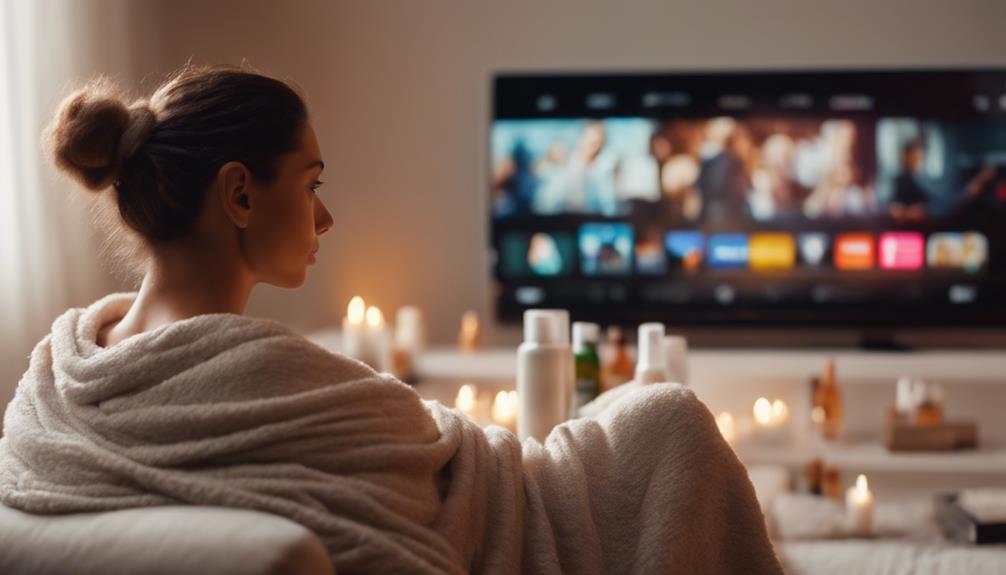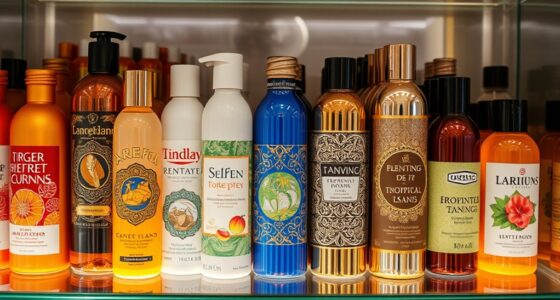Melanin protects your skin by absorbing UV rays and neutralizing free radicals, reducing your risk of DNA damage and skin cancer. When exposed to UV light, your body boosts melanin production through signals like α-MSH binding to its receptors, darkening your skin as a natural barrier. While tanning may seem attractive, it can harm your skin, and myths about safe tanning persist. Keep exploring to learn more about how your skin responds to sun exposure and ways to protect it.
Key Takeaways
- Tanning stimulates melanin production by activating melanocytes through UV exposure, leading to darker skin.
- Melanin absorbs and scatters UV rays, providing natural protection and reducing skin damage during tanning.
- Increased eumelanin in darker skin offers better UV protection and lowers skin cancer risk.
- Excessive UV exposure from tanning damages DNA, accelerates aging, and increases skin cancer risk.
- No safe tanning exists; minimal sun exposure or alternatives like supplements are safer ways to maintain vitamin D.
Understanding Melanin and Its Functions
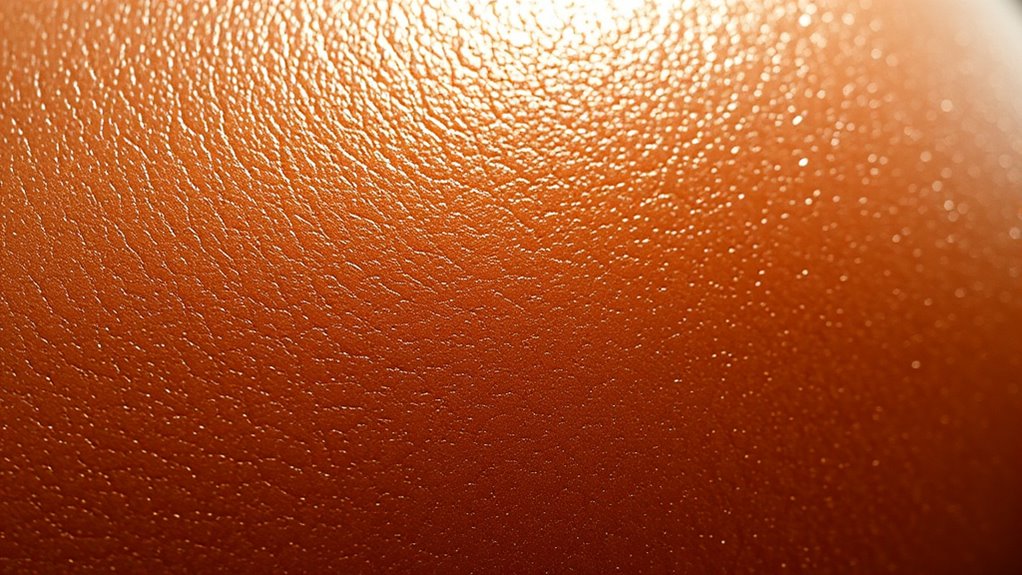
Understanding melanin and its functions is essential to grasp how skin, hair, and eye colors develop and how our bodies protect themselves from sunlight. Melanin exists mainly in three forms: eumelanin, pheomelanin, and neuromelanin. Eumelanin gives skin, hair, and eyes their brown and black shades, while pheomelanin produces red and yellow hues. Neuromelanin is found in the brain and influences neuron color but doesn’t affect external pigmentation. Melanin is stored in melanosomes within melanocytes, which transfer pigment to skin cells. Its primary role is protecting us from harmful UV radiation by absorbing it and converting it into harmless heat. Melanin also acts as an antioxidant, neutralizing free radicals, and helps prevent DNA damage, reducing skin cancer risks.
How Tanning Stimulates Melanin Production
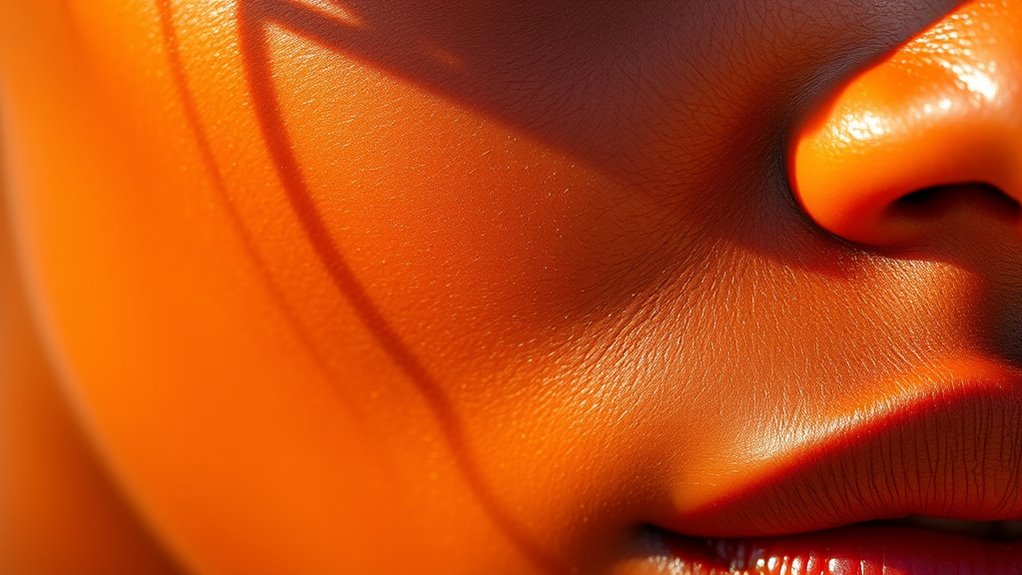
When your skin is exposed to ultraviolet (UV) radiation from the sun or tanning beds, it triggers a series of responses designed to protect your cells from damage. UV rays activate melanocytes, the cells responsible for melanin production, by stimulating a signal transduction pathway. This process involves hormones like α-MSH binding to the MC1R receptor, which promotes melanogenesis. As a result, keratinocytes and melanocytes work together to produce more melanin, which then disperses throughout the epidermis. Increased transcription of the POMC gene in keratinocytes also boosts melanin synthesis. This response causes your skin to darken, creating a natural barrier that helps shield your deeper layers from further UV damage. Basically, tanning is your skin’s way of reinforcing its defense against harmful rays.
The Role of Melanin in Protecting Your Skin

Have you ever wondered how your skin naturally shields itself from harmful ultraviolet rays? Melanin absorbs a wide range of rays, including UVA, UVB, UVC, and blue light, preventing them from reaching deeper skin layers. It acts as a physical barrier by scattering UV radiation, reducing its penetration through the epidermis. The protective power of melanin roughly corresponds to an SPF of 1.5 to 4, meaning it can block about 50% to 75% of UVR. Darker skin, rich in eumelanin, offers superior UV protection compared to lighter skin with more pheomelanin, which provides less defense. Additionally, melanin’s antioxidant properties neutralize reactive oxygen species generated by UV exposure, reducing oxidative stress, DNA damage, and the risk of skin aging and cancer. Its effectiveness is partly due to its absorption capacity, which varies among individuals based on melanin type and concentration. The distribution of melanin also influences their overall skin protection level. Moreover, melanin synthesis can be affected by genetic factors and exposure to sunlight, impacting individual skin responses.
The Biological Pathways Behind Melanin Regulation
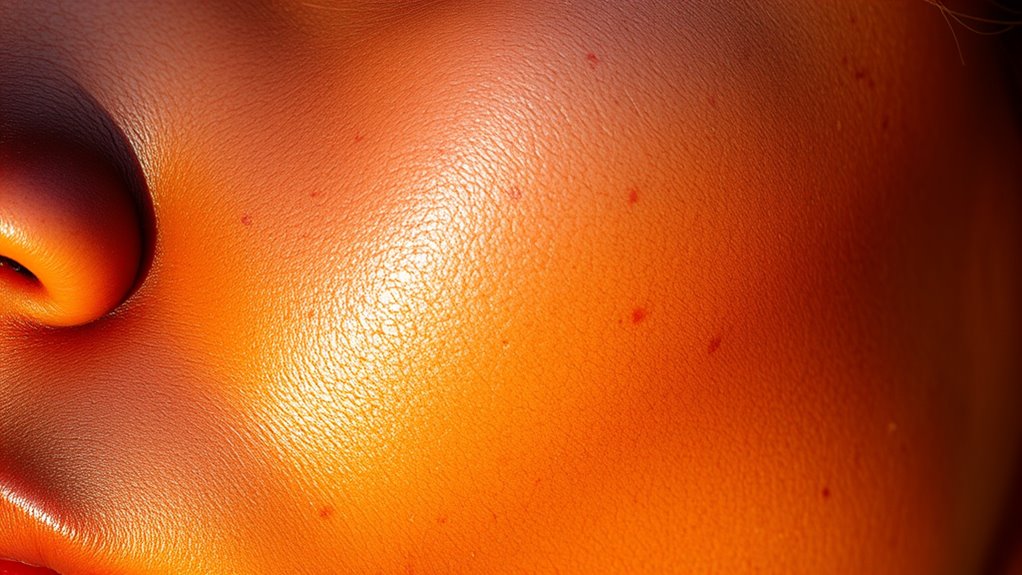
The regulation of melanin production in your skin involves a complex network of signaling pathways that respond to environmental and genetic factors. When UV exposure occurs, it stimulates POMC expression, increasing α-MSH levels. This peptide activates the MC1R receptor, boosting cAMP levels, which then activates CREB and enhances MITF expression—the master regulator of melanogenesis. MITF controls genes like TYR, TYRP-1, and TYRP-2, essential for melanin synthesis. Other pathways, such as Wnt and MAPK/ERK, influence MITF activity and melanocyte behavior. The KIT and SCF signaling also modulate melanin production. Together, these pathways coordinate to regulate melanin synthesis within melanosomes in melanocytes, ultimately determining your skin’s pigmentation response to environmental cues like UV radiation. Additionally, homeostasis of pigmentation is maintained through feedback mechanisms that adjust melanin production based on ongoing environmental stimuli. Understanding the signaling pathways involved can help in developing targeted treatments for pigmentation disorders. For example, recent research has highlighted the importance of feedback regulation in preventing overproduction of melanin, which can lead to hyperpigmentation. Moreover, research into these pathways can provide insights into skin cancer prevention and therapy by understanding how melanin regulation impacts cellular growth. Recognizing how these pathways interact can also guide the development of cosmetic treatments aimed at modifying skin pigmentation safely.
Myths, Risks, and Cultural Perspectives on Tanning

Many people believe that tanning is a safe way to enhance their appearance, but this is a widespread myth. There’s no safe way to tan from UV exposure because it damages your DNA, increasing skin cancer risk. Indoor tanning is just as risky—tanning beds emit UV rays far stronger than midday sun. A base tan doesn’t protect you from damage or premature aging. Vitamin D can be produced safely with minimal sun or supplements, no tanning needed. Both natural and artificial UV exposure accelerate skin aging and cause long-term damage. Culturally, tanning is linked to beauty and status in some societies, but misconceptions persist. The idea that tanning benefits health or prevents aging is false. Public health efforts aim to dispel these myths and promote safer alternatives like sunless tanning. Additionally, understanding the long-term skin damage caused by UV exposure can help individuals make informed choices about sun safety. Recognizing the dangers of UV rays emphasizes the importance of protective measures such as sunscreen and clothing. It is also important to be aware that mammography guidelines for detecting breast cancer are continuously refined to balance benefits and risks in screening practices. Staying informed about private placement equity markets can also guide investors in making educated decisions about various sectors, including those related to health and safety investments. Moreover, awareness of protective clothing options can further reduce UV exposure during outdoor activities.
Frequently Asked Questions
Can Genetic Factors Influence Individual Melanin Levels and Tanning Response?
Yes, genetic factors can influence your melanin levels and how your skin responds to sun exposure. You inherit genes like MC1R and TYR that regulate melanin production, affecting your natural pigmentation and tanning ability. Variations in these genes mean some people produce more melanin and tan easily, while others have less. Your genetic background, combined with environmental factors, shapes how your skin reacts to sunlight and determines your tanning response.
Are There Natural Ways to Enhance Melanin Production Safely?
You wonder if there are natural, safe ways to boost melanin production. To do this, focus on eating a colorful, antioxidant-rich diet, including vegetables and fruits high in vitamins A, C, and E. Maintain a balanced lifestyle, avoid overexposure to UV rays, and protect your skin with sunscreen. While supplements and herbs are popular, there’s limited scientific proof they reliably increase melanin, so prioritize natural habits for skin health.
How Does Melanin Impact Skin Aging and Wrinkle Formation?
Think of melanin as your skin’s shield, fighting off age’s silent advance. It delays wrinkles by absorbing harmful UV rays, keeping your skin youthful longer. With more melanin, your skin ages more slowly, showing fewer wrinkles and less sagging. As you age and melanin decreases, your skin becomes more vulnerable, highlighting the importance of sun protection and gentle skincare. Embrace your natural defense to preserve your glow through the years.
Can Artificial Melanin or Synthetic Pigments Provide UV Protection?
You might wonder if artificial melanin or synthetic pigments can offer UV protection. They do, often more effectively than natural melanin, by absorbing UV rays better and speeding up skin healing. These innovations are still being researched, but they show promise in enhancing skin defense, reducing damage, and potentially supplementing sunscreens. While not yet widely available, they could soon provide advanced options for stronger, safer UV protection.
What Are the Latest Advancements in Melanin Research for Skin Health?
When it comes to recent breakthroughs, you’re really hitting the jackpot. Researchers have developed synthetic “super melanin” that speeds up skin healing, enhances UV protection, and may even treat radiation burns. These advancements could revolutionize skin care, offering more effective sunscreens and therapies. By revealing melanin’s secrets, you get closer to better skin health and protection, making your skin more resilient against environmental stressors.
Conclusion
Now that you understand how melanin works and how tanning affects your skin, you might think twice before chasing that perfect glow. But there’s more to discover—hidden risks and surprising truths that could change your perspective forever. Will you continue to seek that sun-kissed look, or choose a safer path? The choice is yours, and the story isn’t over yet. Stay curious—what you uncover next might just surprise you.


